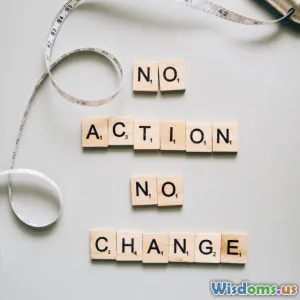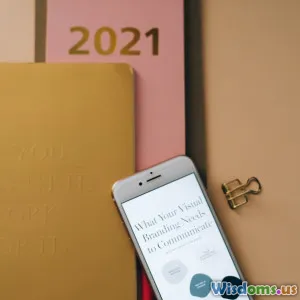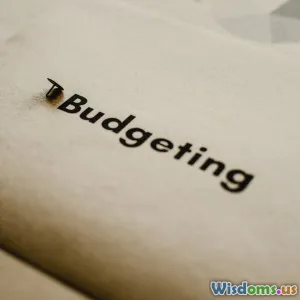
Stop Waiting for Motivation Try These Action First Strategies Today
9 min read Discover practical action-first strategies to boost productivity and success without waiting for motivation. (0 Reviews)
Stop Waiting for Motivation: Try These Action-First Strategies Today
Motivation is often hailed as the golden key to success—the elusive spark we await before starting anything meaningful. Yet, many of us find ourselves trapped in an endless waiting game, telling ourselves, "I'll start once I feel motivated." Unfortunately, motivation doesn’t always come on cue; it ebbs and flows unpredictably. What if you didn't have to wait for motivation to kickstart progress?
In this article, we will explore why waiting for motivation is a trap and reveal powerful action-first strategies you can use right now to tap into momentum, boost productivity, and drive success—regardless of your current motivation levels.
Why Waiting for Motivation Often Backfires
Motivation Is Unpredictable and Fleeting
Relying on motivation to initiate tasks is like relying on the weather to hold your outdoor plans—it changes unexpectedly. According to behavioral science, motivation fluctuates daily due to biological rhythms, mood fluctuations, and external stimuli. For example, research from psychologist Dr. Tim Pychyl highlights that motivation tends to be reactive and short-lived, which explains why people procrastinate even on tasks they desire to accomplish.
The Myth of Motivation as a Prerequisite
We often envision motivation as a mysterious internal force granting us unstoppable drive, but motivation tends to be a result of action, not just a cause. Behavioral expert BJ Fogg, in his "Tiny Habits" method, emphasizes that starting with small behaviors, no matter how insignificant, leads to habit formation and eventually builds motivation.
The Motivation-Procrastination Loop
Waiting for motivation often slips into procrastination territory. The more you delay, the more your brain associates the task with aversion, reinforcing avoidance. It’s a self-sabotaging cycle countless people experience before big presentations, deadlines, or important life changes.
Action-First Strategies to Overcome the Motivation Hang-up
Here’s where you shift gears from passively waiting for motivation to proactively creating momentum with concrete, proven strategies.
1. Implement the 2-Minute Rule
Inspired by David Allen’s "Getting Things Done" methodology, the 2-Minute Rule states: If a task takes less than two minutes, do it immediately. Starting small drastically reduces the mental barrier to action. Once the small task is done, the odds increase that you’ll continue working on more complex tasks.
Example: Instead of waiting to work out when motivated, just put on your sneakers and stretch for two minutes. More often than not, this tiny action propels you to a full session.
2. Use the “Pomodoro Technique” to Harness Time
Developed in the late 1980s by Francesco Cirillo, the Pomodoro Technique uses intervals of focused work (usually 25 minutes) followed by short breaks. This structure combats the overwhelming feeling that kills motivation, breaking large projects into bite-sized, less intimidating segments.
Example: If writing a report seems daunting, commit to just 25 minutes of focused writing. After the timer, you can stop or continue.
3. Create External Accountability
According to a study by Dr. Gail Matthews at Dominican University, people are 65% more likely to achieve goals just by writing them down, and even more so with accountability partners. Telling a friend, colleague, or coach about your task adds social responsibility, pushing you to act.
Example: Schedule a regular progress check-in with a peer to discuss daily or weekly goals.
4. Establish Micro-Habits That Require No Motivation
BJ Fogg recommends designing habits that take very little effort, such as "after I brush my teeth, I'll read one sentence." Over time, these micro-habits compound without relying on your fluctuating motivation.
Example: Want to read more? Start by reading a single page each day—this minimal commitment reduces the hurdle of starting.
5. Leverage Environmental Design
Our environment heavily influences behavior. Research reveals that the proximity and visibility of items can either promote or hinder action. By redesigning your workspace to trigger action, motivation will be less important.
Example: Place your journal or exercise clothes where you see them first thing in the morning. This subtle visual cue compels action without the need for motivation.
6. Adopt a “Do It Afraid” Mindset
Psychologist Susan Jeffers popularized the notion that action and courage go hand-in-hand. Fear or lack of motivation doesn't disappear before you start; it diminishes as you move forward.
Example: Start calling a potential client despite nervousness or lack of inspiration. Each call builds courage, momentum, and ultimately, motivation.
Real-World Insights: How Action Drives Success
Case Study: Mel Robbins and the 5-Second Rule
Mel Robbins, a motivational speaker and author, introduces the "5-Second Rule," which prompts you to count backward from 5 to 1 and then immediately take action. According to Robbins, interrupting hesitation with a simple countdown prevents hesitation and self-doubt. Thousands have reported overcoming inertia and initiating tasks by applying this rule.
Corporate Productivity Trends
Companies utilizing micro-movements, structured work intervals like Pomodoro, and accountability methods have seen measurable productivity growth. For instance, Atlassian reports an estimated 15-20% boost in team performance after adopting focus-centered techniques paired with environmental adjustments.
The Science of Momentum: Willpower Is Finite
Research by Baumeister et al. identifies willpower as a limited resource that depletes with overload. Starting with small, manageable tasks conserves willpower and ultimately sustains higher productivity, debunking the need for waiting until you ‘feel’ like performing.
Conclusion: Take Action, Let Motivation Follow
Motivation isn’t a magical lightning bolt that must strike before you work. Instead, imagine motivation as a flame kindled through consistent sparks of action. Waiting passively for motivation only leads to lost time, opportunities, and frustration.
By integrating action-first techniques—like the 2-minute rule, Pomodoro Technique, accountability partnerships, micro-habits, environmental design, and embracing fear—you empower yourself to move forward today. The truth is clear: take the first step now, and motivation will follow in stride.
Remember the words of famed author Stephen King, "Amateurs sit and wait for inspiration, the rest of us just get up and go to work." Don’t wait—get started with these strategies and experience the ripple effect that takes you from procrastination to progress.
References
- Pychyl, T. A. (2013). Solving the Procrastination Puzzle: A Concise Guide to Strategies for Change. TarcherPerigee.
- Fogg, B. J. (2019). Tiny Habits: The Small Changes That Change Everything. Houghton Mifflin Harcourt.
- Jeffers, S. (1997). Feel the Fear and Do It Anyway. Ballantine Books.
- Robbins, M. (2017). The 5 Second Rule: Transform Your Life, Work, and Confidence with Everyday Courage. Savio Republic.
- Baumeister, R. F., & Tierney, J. (2011). Willpower: Rediscovering the Greatest Human Strength. Penguin Books.
- Matthews, G. (2015). Goal-setting effectiveness and accountability measures. Dominican University of California Study.
Rate the Post
User Reviews
Popular Posts


















